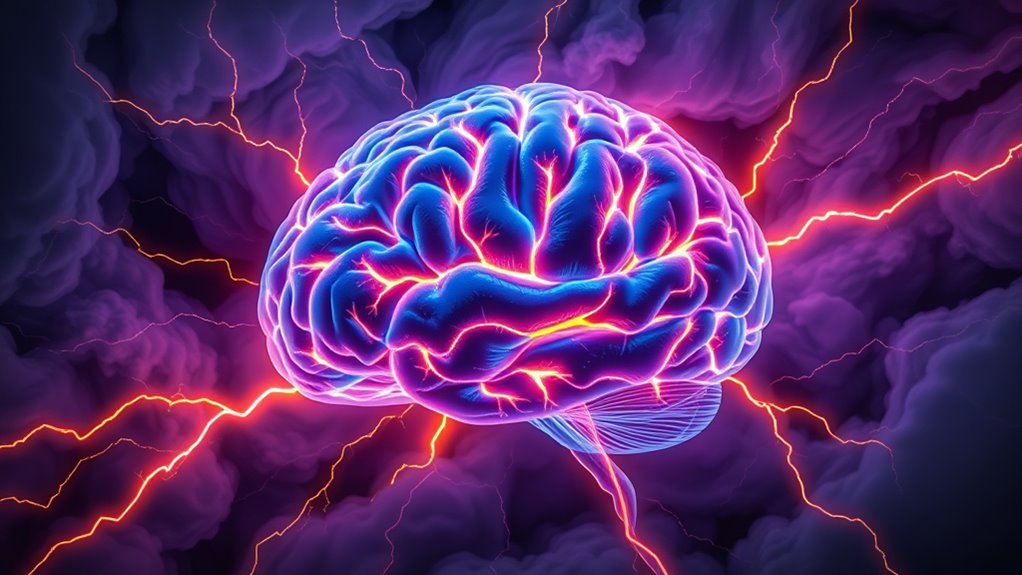Stress actively changes your brain’s wiring by influencing neural connections, especially in key areas like the hippocampus, prefrontal cortex, and amygdala. Acute stress causes quick adaptations, but chronic stress can damage these regions, impairing memory, decision-making, and emotional control. Your brain’s neuroplasticity means it can reorganize both positively and negatively based on stress levels. Keeping stress in check helps protect your brain’s resilience—if you want to know more, keep exploring how your mind adapts and recovers.
Key Takeaways
- Stress triggers neuroplastic responses that can strengthen or weaken neural connections, affecting brain adaptability.
- Acute stress activates the amygdala and temporarily disrupts hippocampal function, influencing memory and emotion.
- Chronic stress causes structural changes, shrinking the hippocampus and enlarging the amygdala, leading to anxiety and memory issues.
- Stress hormones like cortisol modulate synaptic connections, potentially causing maladaptive neural rewiring over time.
- Engagement in stress-reduction activities promotes beneficial neuroplasticity, enhancing resilience and emotional regulation.
Understanding Neuroplasticity: The Brain’s Rewiring Capabilities
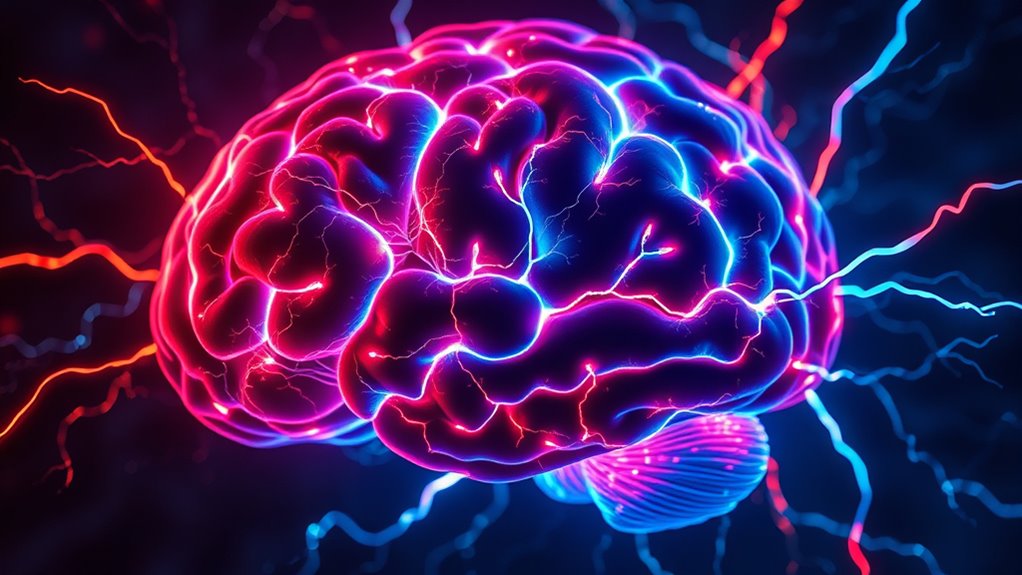
Neuroplasticity refers to the brain’s remarkable ability to reorganize itself by forming new neural connections throughout your life. This process involves neurogenesis enhancement, where new neurons develop, especially in regions like the hippocampus, supporting learning and memory. Simultaneously, synaptic pruning eliminates weaker or unnecessary connections, making your brain more efficient. When you learn a new skill or experience, your brain rewires itself by strengthening relevant synapses and pruning those that aren’t useful. This constant remodeling allows your neural network to adapt to new information and challenges. AI security advancements highlight the importance of understanding neural adaptability and resilience. Recognizing the role of brain plasticity underscores that your brain is not static but a dynamic organ capable of growth and change, even into adulthood. Additionally, ongoing research into neural regeneration demonstrates how the brain can recover from injury and adapt to various environmental stressors, emphasizing the importance of neuroplasticity mechanisms in overall brain health. Moreover, recent studies reveal that engaging in stimulating activities can actively promote neural plasticity and resilience against cognitive decline.
The Impact of Acute Stress on Brain Structures
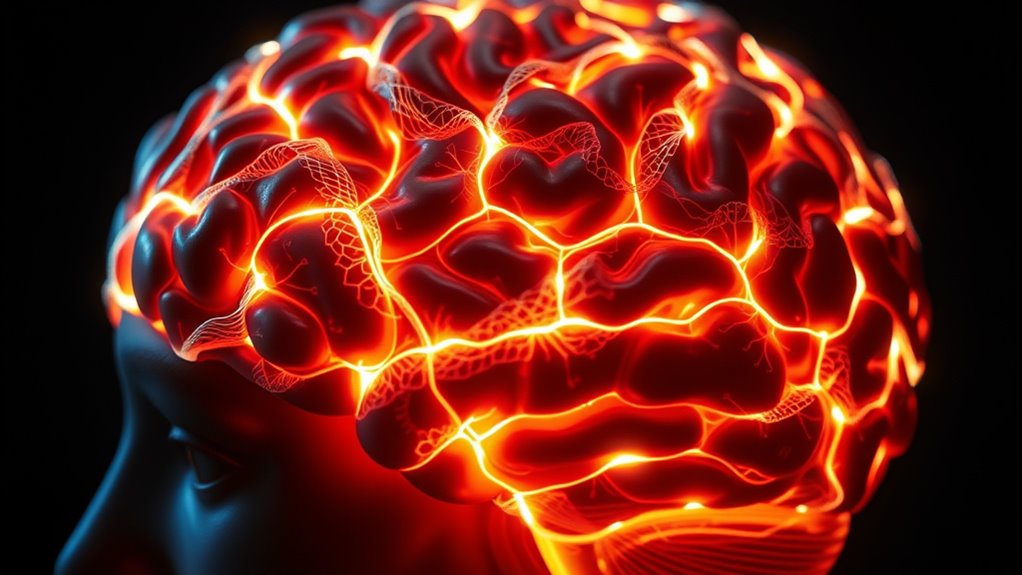
When you encounter acute stress, your brain responds quickly by activating specific structures to help you cope. The amygdala, responsible for processing emotions, becomes highly active, heightening your emotional regulation efforts. Meanwhile, the prefrontal cortex, which supports cognitive flexibility, temporarily adjusts to manage immediate challenges. This shift can make you more reactive or less adaptable, impacting how you handle new information or changing circumstances. Your hippocampus, involved in memory formation, may also experience brief disruptions, affecting your ability to contextualize stress. These rapid changes are part of your brain’s neuroplastic response, allowing quick adaptation. Additionally, research shows that brain plasticity enables the brain to reorganize itself, which can be beneficial or detrimental depending on the context. However, repeated acute stress can lead to longer-lasting modifications, influencing your emotional regulation and cognitive flexibility over time. Recognizing the importance of fatherly guidance and support can help mitigate the negative effects of stress on the brain. Additionally, understanding the principles of neuroplasticity can encourage strategies to strengthen resilience and recovery from stress-related impacts. Neuroplastic responses enable the brain to reorganize itself, which can be beneficial or detrimental depending on the context.
Chronic Stress and Its Effects on Neural Networks
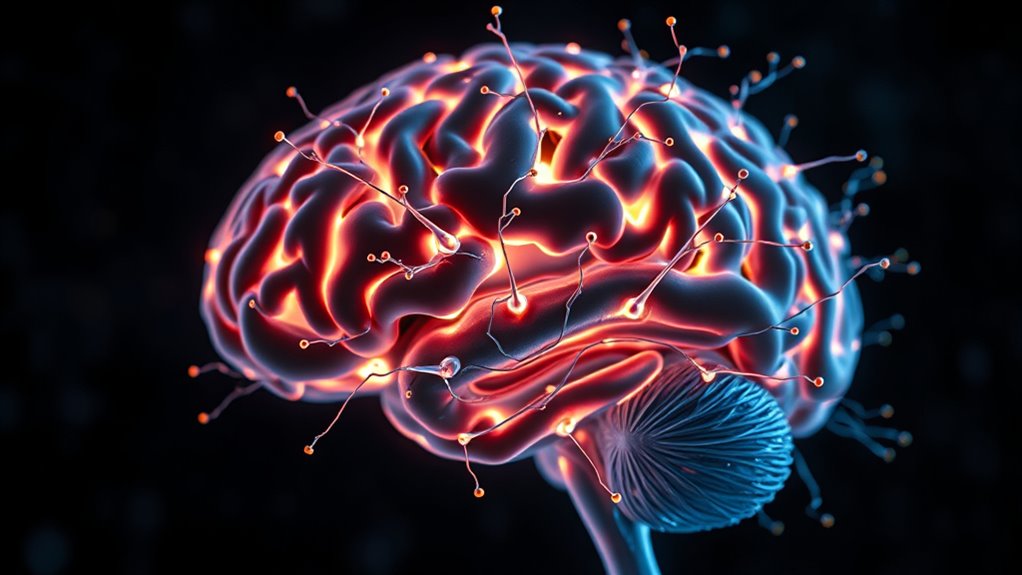
Chronic stress can markedly disrupt your neural circuits, leading to impairments in how your brain processes information. Over time, these disruptions cause lasting changes in brain structure and function. Understanding these long-term effects helps you grasp how sustained stress can shape your neural networks. For example, prolonged stress may influence neuroplasticity, altering the brain’s ability to adapt and recover from injury. Additionally, chronic stress can impact the development of key brain regions involved in emotion regulation and cognitive functions, further affecting overall mental health. The ongoing activation of stress pathways can also lead to hormonal imbalances, which further exacerbate neural damage and functional decline. Moreover, chronic stress can hinder neural regeneration, making it more difficult for the brain to repair itself after injury. Recognizing how adaptive processes are affected by stress emphasizes the importance of managing chronic stress to protect brain health.
Neural Circuit Disruption
Chronic stress actively alters neural circuits, disrupting the intricate balance of brain networks responsible for mood, cognition, and behavior. This neural circuit disruption occurs when stress hormones, like cortisol, impair synaptic connections, leading to synaptic imbalance. As a result, communication between neurons becomes less efficient, weakening key pathways in areas such as the hippocampus and prefrontal cortex. You might notice difficulties in memory, decision-making, or emotional regulation, as these circuits struggle to function properly. Over time, this disruption hampers your brain’s ability to adapt and respond to challenges. By altering synaptic strength and connectivity, chronic stress fundamentally shifts how your neural networks process information, setting the stage for more profound changes down the line. Additionally, relationships can suffer, as emotional regulation becomes more difficult and social interactions are affected. Understanding these effects can help in developing strategies to mitigate stress-related brain changes and promote resilience. Recognizing the importance of neuroplasticity can motivate proactive efforts to support brain health in stressful environments. Moreover, these changes highlight the importance of cybersecurity vulnerabilities during periods of systemic stress, as external threats may exploit weakened neural defenses. As research advances, understanding how brain adaptability is impacted by chronic stress can inform interventions to restore neural balance and improve mental health outcomes.
Long-term Brain Changes
Prolonged exposure to stress hormones like cortisol leads to lasting changes in your brain’s neural networks. Over time, this can impair your stress management and reduce cognitive flexibility, making it harder to adapt to new situations. Chronic stress can shrink the hippocampus, weaken the prefrontal cortex, and enhance amygdala activity, reinforcing anxiety and emotional responses. These changes solidify neural patterns that hinder resilience. Here’s a snapshot of long-term brain effects: neural plasticity. Continuous stress may also influence brain adaptability, further complicating recovery and mental health. Additionally, these neural alterations can contribute to mental health disorders, emphasizing the importance of managing stress effectively. Recognizing how stress impacts brain health underscores the need for effective stress reduction strategies to support neural resilience.
Stress Hormones and Their Role in Brain Adaptation
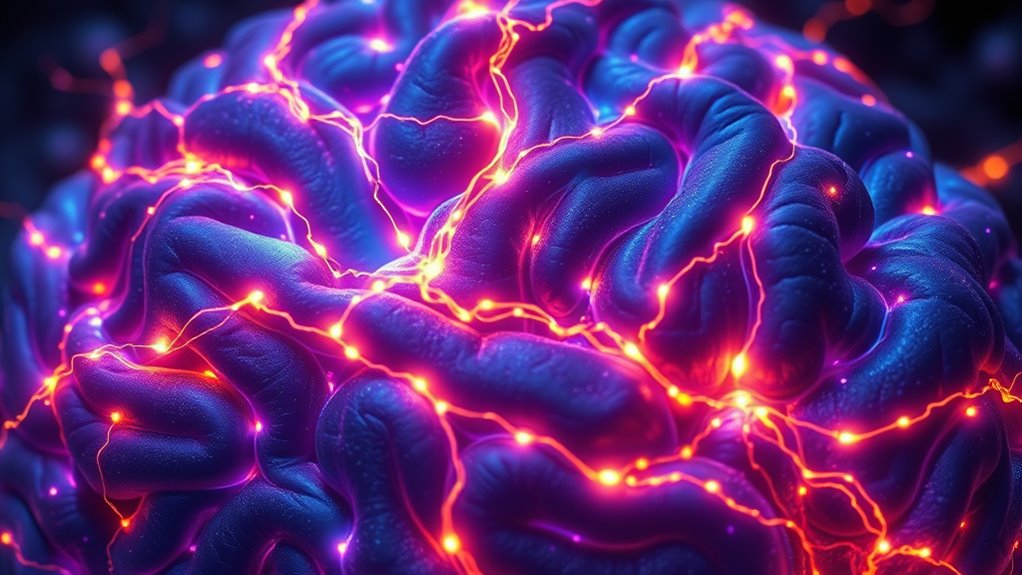
Stress hormones, such as cortisol and adrenaline, play a essential role in how your brain adapts to challenging situations. Cortisol effects include increasing energy availability, modulating inflammation, and shaping neural pathways involved in memory and learning. When you face stress, adrenaline triggers immediate responses like increased heart rate and alertness, preparing you for action. These adrenaline responses sharpen your focus and boost physical readiness. Over time, cortisol influences neuroplasticity by altering synaptic connections, which can either strengthen adaptive pathways or lead to harmful changes if stress persists. Your brain’s ability to rewire itself relies heavily on these hormones, enabling quick adaptation in acute stress but risking detrimental effects with chronic exposure. Understanding their roles helps you grasp how stress hormones influence brain resilience and vulnerability. Additionally, repetitive stress can lead to maladaptive neural changes if not managed properly, highlighting the importance of stress regulation techniques. self-directed IRA strategies can empower individuals to diversify their investments and build financial resilience against economic stressors.
The Double-Edged Sword: Beneficial vs. Detrimental Changes
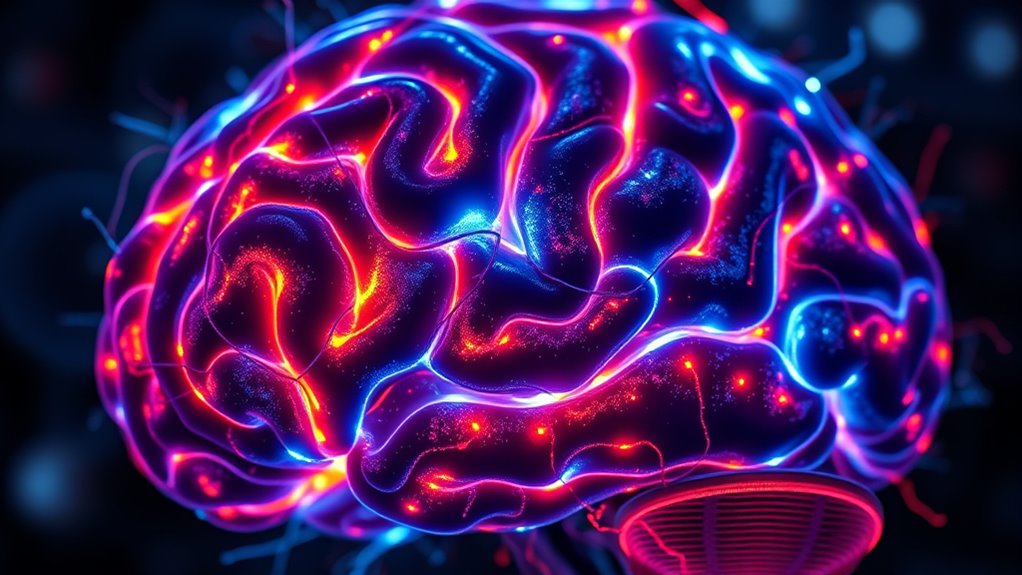
You might notice that stress can lead to positive brain changes, like improved resilience or problem-solving skills. However, it can also cause lasting damage, such as chronic anxiety or memory issues. Understanding how stress triggers both adaptive and maladaptive rewiring helps you see its complex role in brain health.
Adaptive vs. Maladaptive Changes
Neuroplasticity allows the brain to adapt by strengthening useful connections, but these changes can also backfire if they’re maladaptive. When stress alters neurotransmitter dynamics, it can reinforce harmful pathways, leading to anxiety or depression. Conversely, adaptive changes like synaptic pruning help eliminate unnecessary connections, promoting resilience. Understanding this balance is vital for recognizing how your brain responds to stress.
| Effect | Benefit | Risk |
|---|---|---|
| Neurotransmitter | Enhances mood regulation | Amplifies stress responses |
| Synaptic pruning | Improves efficiency | Removes essential connections |
| Strengthening | Builds resilience | Reinforces maladaptive patterns |
| Weakening | Reduces overactivation | Impairs necessary functions |
Lasting Brain Rewiring
While brain rewiring through neuroplasticity can foster recovery and learning, it also carries risks of creating lasting, maladaptive patterns if the changes reinforce harmful pathways. Neuroplasticity therapies and targeted brain training can help reshape your brain positively, but if misapplied, they may entrench negative habits or fears. For example, repetitive negative thought patterns can become deeply embedded, making it harder to break free. You need to be mindful of how these interventions influence your neural circuits. The goal is to promote adaptive rewiring that supports resilience and mental health, rather than reinforcing stress or anxiety. Recognizing this double-edged nature ensures you harness neuroplasticity tools effectively, avoiding unintended, long-lasting detrimental effects.
Brain Regions Most Affected by Stress-Induced Plasticity
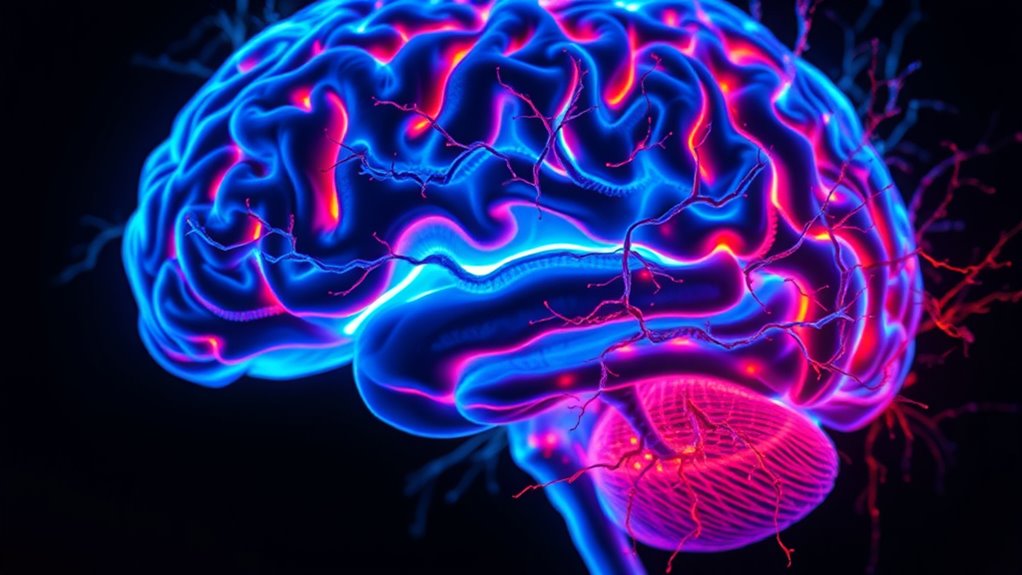
When stress occurs, certain brain regions undergo significant changes in their structure and function, highlighting their vulnerability to stress-induced plasticity. The hippocampus is especially affected, experiencing decreased neurogenesis enhancement and increased synaptic pruning, which can impair memory and learning. The prefrontal cortex also undergoes structural changes, leading to compromised decision-making and emotional regulation. The amygdala tends to become hyperactive, with increased synaptic connectivity that heightens anxiety and fear responses. These regions are highly plastic and responsive to stress, making them susceptible to lasting alterations. Understanding these changes helps you recognize how stress can reshape critical areas of your brain, potentially influencing your mental health and resilience over time.
Strategies to Harness Neuroplasticity for Mental Resilience
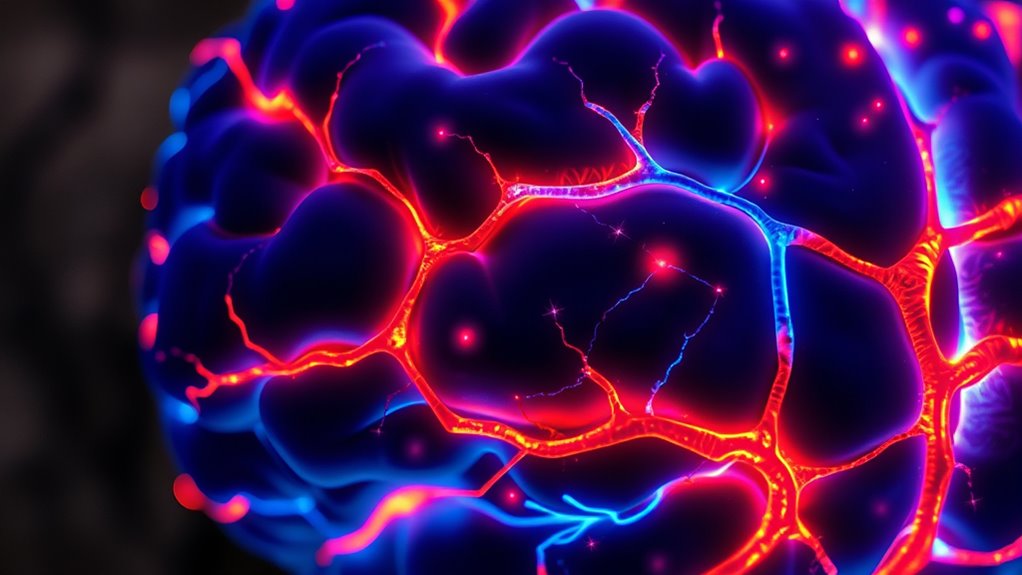
Understanding how stress alters key brain regions highlights the importance of actively shaping your neural pathways to build resilience. You can do this through practices like mindfulness meditation, which reduces stress and promotes adaptive brain changes. Building social support networks strengthens your emotional resilience, helping your brain recover from stress more effectively. To maximize neuroplasticity, consider these strategies:
| Practice | Impact | Focus Area |
|---|---|---|
| Mindfulness Meditation | Enhances emotional regulation, reduces cortisol | Stress management |
| Social Support | Boosts oxytocin, promotes positive neural pathways | Emotional resilience |
| Consistent Exercise | Improves mood, stimulates neurogenesis | Brain health and flexibility |
Engaging consistently in these activities rewires your brain, fostering mental resilience against future stressors.
Future Directions in Stress and Brain Research
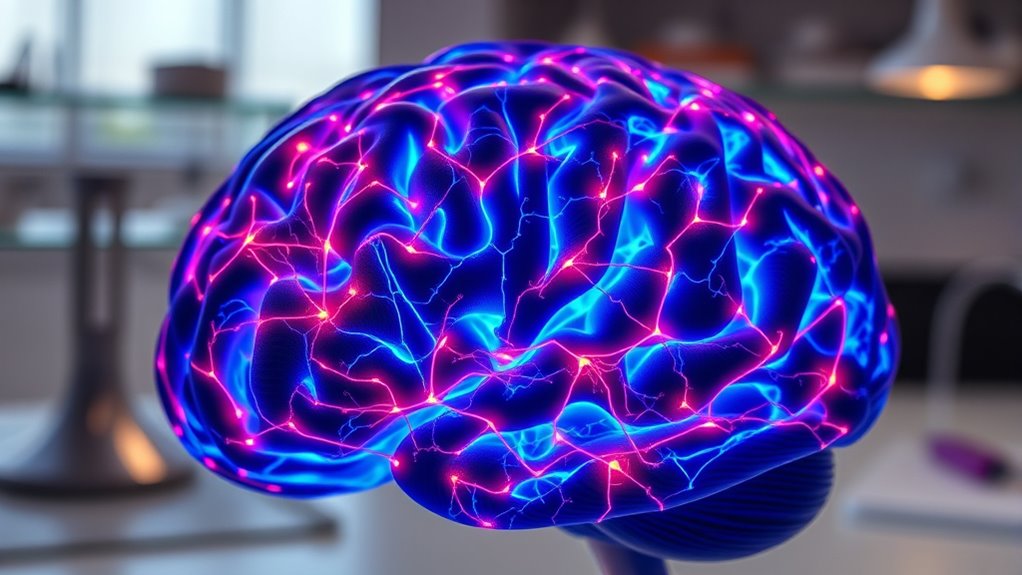
Advancements in neuroimaging and molecular techniques are propelling stress and brain research into an exciting new era. You can now explore how neurotransmitter modulation influences stress responses and neuroplasticity more precisely. Researchers are investigating how stress affects synaptic pruning, which shapes neural circuits and impacts resilience or vulnerability. Future studies aim to map these processes in real time, revealing how chronic stress alters brain architecture. This progress could lead to targeted therapies that modify neurotransmitter systems or optimize synaptic pruning, potentially reversing harmful effects of stress. By integrating cutting-edge imaging with molecular insights, you’ll gain a deeper understanding of how stress rewires the brain, opening doors for innovative interventions that promote mental health and resilience.
Practical Tips for Managing Stress to Protect Brain Health
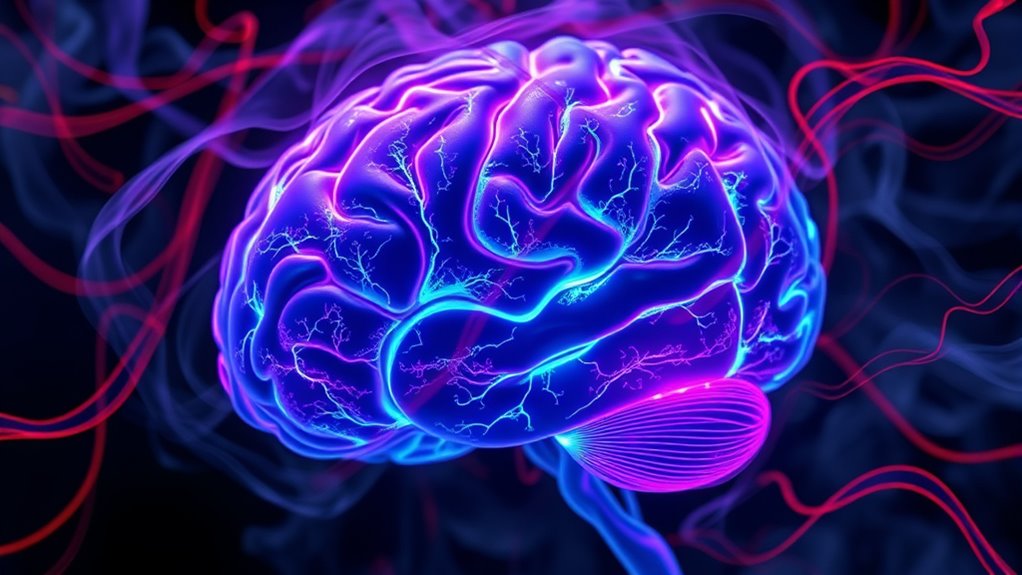
As research uncovers how stress reshapes neural circuits and impacts brain health, adopting practical strategies to manage stress becomes increasingly important. To protect your brain, try incorporating mindfulness meditation into your daily routine; it helps calm your mind and reduce cortisol levels. Prioritize sleep hygiene by establishing consistent sleep schedules and creating a relaxing bedtime environment— quality sleep is essential for brain resilience. Regular physical activity also releases endorphins, which counteract stress. Practice deep breathing exercises or progressive muscle relaxation during stressful moments. Finally, limit exposure to screens and news before bed to improve sleep quality and reduce anxiety. These simple yet effective habits can help you manage stress better and safeguard your neuroplasticity.
Frequently Asked Questions
Can Neuroplasticity Help Reverse Stress-Related Brain Damage?
Stress can cause damage to your brain, but neuroplasticity offers hope. By practicing stress management techniques like mindfulness, exercise, and proper sleep, you can promote cognitive resilience and help your brain recover. Neuroplasticity allows your brain to adapt and form new connections, potentially reversing some stress-related damage. With dedication to healthy habits, you can support your brain’s healing process and strengthen your mental health over time.
How Quickly Can the Brain Adapt to Stress Through Neuroplasticity?
Your brain can adapt to stress pretty quickly, often within days to weeks, as part of its natural stress response. When you experience stress, your brain undergoes neuroplastic changes that enhance resilience and coping skills. The speed of this brain adaptation depends on factors like your environment, mindset, and how actively you engage in stress management techniques. Consistent practice helps reinforce positive neuroplastic changes, improving your overall stress response over time.
Are There Individual Differences in Stress-Induced Brain Changes?
You might notice that stress affects your brain differently than others do. Individual differences in stress-induced brain changes often stem from genetic predispositions and personality traits. These factors influence how your brain adapts to stress, making some people more resilient while others are more vulnerable. Your unique biology and character shape the neuroplasticity response, meaning your experience of stress’s impact on your brain varies markedly from someone else’s.
Does Age Affect the Brain’s Ability to Undergo Neuroplastic Changes From Stress?
You might wonder if age limits your brain’s ability to adapt through neuroplasticity when under stress. As you age, developmental stages influence this capacity, with younger brains generally more flexible. However, even older adults can experience meaningful neuroplastic changes, though they might require different approaches or longer periods. So, while age can affect neuroplasticity, it doesn’t entirely eliminate your brain’s ability to adapt and recover from stress.
Can Lifestyle Modifications Enhance Beneficial Neuroplasticity Under Stress?
Think of your brain like a garden that needs care. Yes, lifestyle changes like mindfulness practices and physical activity can boost beneficial neuroplasticity even under stress. These habits act as nutrients, helping your brain grow stronger and more adaptable. Regular exercise and mindfulness not only reduce stress but also promote positive neural connections, making it easier to handle future challenges and foster resilience in your brain’s wiring.
Conclusion
Understanding how stress reshapes your brain is like tending a delicate garden—you need to nurture it carefully. By recognizing how acute and chronic stress affect your neural pathways, you can take steps to foster resilience. Remember, your brain’s plasticity is a powerful tool, capable of both growth and recovery. With mindful strategies, you can steer your brain’s rewiring in a positive direction, just as a skilled gardener guides growth through mindful care.
